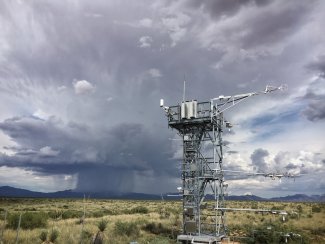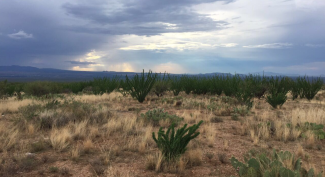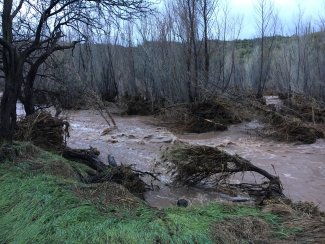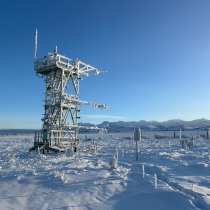Getting to Know the NEON Domains: Desert Southwest
June 16, 2021
View the Desert Southwest Domain storymap here!
This blog series explores each of the 20 NEON Domains and the field sites within them.
If you like it hot, the Desert Southwest may be for you. From the iconic saguaro cactus stands of the Sonoran to the mesquite scrublands of the Chihuahuan, this region offers a diverse range of desert and mountainous landscapes to explore. Data from the NEON field sites will help scientists better understand the impact of human disturbances and long-term weather change on these unique and fragile arid ecosystems.
Defining the Desert Southwest Domain
Domain 14: the Desert Southwest (D14) features three of the four North American deserts: the Mojave (covering southeastern California and southern Nevada), the Sonoran (covering the southern tip of California, southwestern Arizona, and northwestern Mexico), and the Chihuahuan (covering west Texas, parts of New Mexico and Arizona, and north-central Mexico). D14 encompasses 393,000 km2 (152,000 square miles) of the southwestern U.S., including the metropolitan areas of Palm Springs, Phoenix, Tucson, Las Cruces, and El Paso.

Map of Domain 14 - Desert Southwest
Each of these deserts features distinct terrain, flora, and fauna communities.
- The Mojave Desert is a high "rain shadow" desert bordered by the Sierra Nevada, San Gabriel, and San Bernardino ranges. It is the smallest and driest desert in North America, with parts receiving less than 50 mm (2 in.) of precipitation each year. Death Valley, in the northern Mojave, is the lowest and hottest place in the U.S., with summer temperatures often exceeding 40°C (120°F). In winter months, temperatures can drop to -4°C (25°F) in the valleys and -18°C (0°F) at higher elevations. Nearly 2000 species of plants are found within the desert, including the endemic Joshua tree, an indicator species. Creosote bush and numerous species of cacti also thrive here. The desert is home to a number of reptile and small mammal species adapted to desert conditions, along with desert bighorn sheep, coyote, and cougar.
- The Sonoran Desert is known for its famous saguaro cactus, an iconic species that grows wild only here. In contrast to the Mojave to the north, the Sonoran has a subtropical climate with two seasons of rainfall, receiving 75-380 mm (3-15 in.) of precipitation annually. Most of the rain comes during the monsoon season (July–September), with a lighter winter rainy season in December and January. The Sonoran Desert supports more than 2000 plant species, including organ pipe and prickly pear cacti and plants from the agave and palm families. Scrublands with creosote bush, indigo bush, and Mormon tea can be found at lower elevations, giving way to mesquite, palo verde, desert ironwood, and other small trees and shrubs at higher elevations. You can also find more than 350 species of birds, 100 reptile species, and thousands of insect species adapted to desert life. The northernmost population of jaguars lives in the mountains along the U.S./Mexico border.
- The Chihuahuan Desert is a "rain shadow" desert lying between the Sierra Madre Occidental and Sierra Madre Oriental ranges in Mexico, which block rainfall from the Pacific Ocean and the Gulf of Mexico. Like the Sonoran, it has a monsoon season between July and October, which brings in most of its annual precipitation (235 mm/9.3 in. on average). It is at a higher elevation than the Sonoran, which gives it somewhat milder summers and cool winters with occasional freezes. Temperatures can vary widely with elevation, with average annual temperatures ranging from 13-22°C (55-72°F), depending on elevation. The dominant plant species in valley areas is the creosote bush, along with tarbush, yucca, prickly pear, and other cactus species. Arid grasslands and shrublands are also found throughout the Chihuahuan Desert. More than 170 species of reptile and amphibians live here, along with mule deer, pronghorn, grey fox, and black-tailed prairie dogs. The grasslands provide winter habitat for hundreds of bird species.
These three regions showcase the enormous biodiversity within and between the southwestern deserts. Each desert features a unique mix of flora and fauna adapted to their harsh desert environment, with many found nowhere else in the world. In between desert areas, mountains create "sky islands" with cooler, wetter climates. The high, isolated mountain ranges support a variety of different biomes along the elevation gradients, with scrub and grassland transitioning into mixed conifer forests near the peaks.
Domain 14 has three field sites: two terrestrial and one aquatic. Santa Rita Experimental Range and Sycamore Creek are both located in Arizona in the Sonoran Desert, while Jornada Experimental Range is located in New Mexico within the Chihuahuan Desert.
- Jornada Experimental Range (JORN) – Terrestrial
- Santa Rita Experimental Range (SRER) – Terrestrial
- Sycamore Creek (SYCA) – Aquatic
Jornada Experimental Range
The Jornada Experimental Range, managed by the USDA and New Mexico State University, was established in 1912 as a long-term agricultural research station to study the impact of grazing on arid grasslands. Research here was instrumental in the understanding of desertification and woody shrub encroachment on arid grasslands. In addition to continued animal agriculture studies, the center now focuses on desert ecosystem functions, including dust movement and reseeding of native vegetation.

The NEON flux tower at JORN. Photo credit: Robin Luna.
Upland areas here were historically dominated by grasslands featuring black grama, mesa dropseed, and other perennial grasses. The site now features a mix of grassland and desert scrub, with heavy encroachment of woody shrubs such as creosote and honey mesquite into former grassland areas. Native desert animal species include the badger and banner-tailed kangaroo rat. From 1969 to 1973, a population of oryx antelope from the Kalahari Desert in Africa was introduced to the nearby White Sands Missile Range for big-game hunting opportunities. While they are an impressive sight in the Chihuahuan desert, they compete with native pronghorn and other ungulate species.
The San Andreas National Wildlife Refuge, located within White Sands, is one of the few riparian areas between the Rio Grande and the Sacramento Mountains and an important stop for migratory birds. Jornada was designated a UNESCO biosphere reserve in 1976. LTER maintains a nearby research site at Jornada Basin.
Santa Rita Experimental Range
The Santa Rita Experimental Range, located 35 km (21.8 mi.) south of Tucson, Arizona, is the oldest continuously operating rangeland research facility in the U.S. It was managed by the USDA from 1903 until 1988 when control was handed over to the University of Arizona (U.A.). It is now used by the U.A. College of Agriculture and Life Sciences and the School of Natural Resources as an experimental laboratory to study desert ecology, long-term weather change, hydrologic processes, range management, and wildfire. The center boasts a rich trove of data on arid grassland ecosystems and grazing practices going back more than 100 years.

Desert life at the Santa Rita Experimental Range (SRER) in Arizona. Photo credit: Robin Luna.
SRER is located in the foothills of the Santa Rita Mountains. Vegetation cover is highly dependent on elevation. Creosote bush dominates at lower levels, while velvet mesquite and cholla cactus are found in the hills. A mix of short trees and thorny shrubs, cacti and other succulents, perennial grasses, and forbs are found across the site. Among the many distinctive fauna at the range is the carnivorous grasshopper mouse (yes, that one), which eats insects and smaller mammals and has evolved to be immune to the sting of the black scorpion. Plants and animals here are adapted to the bimodal precipitation pattern, with long dry spells punctuated by the heavy thunderstorms of the monsoon season and gentle rains in the winter.
Sycamore Creek
Sycamore Creek is a shallow, intermittent desert stream in the Tonto National Forest, about 35 km (22 mi.) northeast of Phoenix. The site is hosted and managed by the U.S. Forest Service. The surrounding landscape is a typical northern Sonoran scrub ecosystem, with a mix of old-growth saguaro and cacti/palo verde forests. Cattle grazing occurs in parts of the watershed. A number of long-term research programs have been hosted at the site over the last several decades. It is currently a principal investigation site for the Arizona State University biology and ecology programs.

High flow events can affect water quality and alter the physical habitat within stream and river systems. The NEON Domain 14 aquatic site at Sycamore Creek (SYCA) in high-flow condition.
The creek originates in the eastern slopes of the Mazatzal Mountains and flows south to the Verde River. It is one of relatively few riverine wetlands in an otherwise arid region. Cottonwood, willow, sycamore, walnut, and ash can be found along the banks along with wetland grasses and forbs, such as bulrush, southern cattail, and knotgrass. The creek is home to a number of reptile, amphibian, and fish species, including longfin dace, lowland leopard frog, Sonoran mud turtle, and the non-native fathead minnow.
Sycamore Creek is notable for its powerful flash floods during the monsoon season, which can be strong enough to topple trees and present a danger to humans, livestock, and wild animals. These seasonal disturbances erode the banks and abrade the riverbed, resulting in significant changes to morphology.
Monitoring Change in Fragile Ecosystems
Travelers through the desert southwest will discover many unique ecosystems, from the distinctive arid habitats found in each of these three deserts to the lush "sky islands." These ecosystems are both exceptional and fragile. Between human disturbances and long-term weather change, they are also under a high degree of stress.
Periods of drought have become longer and more extreme over the last several decades; 2020 was the driest year on record for the Tucson area. The timing, intensity, and geographic patterns of the monsoon season may also be changing as the planet warms. With precipitation already so low, even small changes in rainfall patterns can have a big impact on desert plants and animals adapted to the monsoon cycles. Warming temperatures and less precipitation in the mountains also mean less snowpack to feed rivers, creeks, and ephemeral streams and washes.
Extended droughts, warmer summers, invasive grasses, and encroachment of woody shrubs into grassland areas have created an elevated risk of wildfires in some areas. Invasive grasses, such as buffelgrass, have turned parts of the Sonoran desert into grassland, providing additional fuel that may increase wildfire frequency and intensity. Because most native desert species are not adapted to wildfire, an increase in fire activity could further threaten endemic species like the saguaro.
A growing human population also puts pressure on desert ecosystems. Population growth in the desert southwest has been double the national average for decades and continues to be strong heading into the 2020s. Higher populations create more stress on limited water reserves. Agriculture, mineral extraction, habitation, and recreation also have an impact on desert ecosystems. Human development is encroaching on lands near all three of the NEON D14 field sites.
In the coming decades, rising temperatures, continued droughts and wildfires, and human settlement will continue to put stress on these unique and beautiful desert habitats. The data gathered at the NEON field sites will enable researchers to monitor these impacts and understand how the desert ecosystems are changing and adapting.

